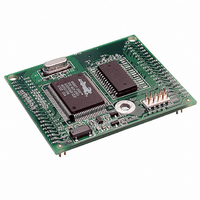20-101-0404 Rabbit Semiconductor, 20-101-0404 Datasheet - Page 70

20-101-0404
Manufacturer Part Number
20-101-0404
Description
MODULE RABBITCORE RCM2000
Manufacturer
Rabbit Semiconductor
Datasheet
1.20-101-0383.pdf
(80 pages)
Specifications of 20-101-0404
Module/board Type
MPU Core Module
Product
Microcontroller Modules
Core Processor
Rabbit 2000
Clock Speed
25.8 MHz
Interface Type
Ethernet, Serial
Flash
256 KB
Timers
5 x 8 bit, 2 x 10 bit
Operating Supply Voltage
4.75 V to 5.25 V
Board Size
48.3 mm x 58.4 mm x 14 mm
Core
RCM2000
Processor Series
RCM2000
Cpu Core
Rabbit 2000
For Use With/related Products
RCM2000
Lead Free Status / RoHS Status
Lead free / RoHS Compliant
Other names
316-1083
C.2 Chip Select Circuit
Figure C-4 shows a schematic of the chip select circuit.
W
W
Figure C-4. Chip Select Circuit
The current drain on the battery in a battery-backed circuit must be kept to a minimum.
When the RCM2000 is not powered, the battery keeps the SRAM memory contents and
the real-time clock (RTC) going. The SRAM has a powerdown mode that greatly reduces
power consumption. This powerdown mode is activated by raising the chip select (CS)
signal line. Normally the SRAM requires Vcc to operate. However, only 2 V is required
for data retention in powerdown mode. Thus, when power is removed from the circuit, the
battery voltage needs to be provided to both the SRAM power pin and to the CS signal
line. The CS control circuit accomplishes this task for the CS signal line.
In a powered-up condition, the CS control circuit must allow the processor’s chip select
signal /CS1 to control the SRAM’s CS signal /CSRAM. So, with power applied, /CSRAM
must be the same signal as /CS1, and with power removed, /CSRAM must be held high
(but only needs to be battery voltage high). Q13 and Q14 are MOSFET transistors with
opposing polarity. They are both turned on when power is applied to the circuit. They
allow the CS signal to pass from the processor to the SRAM so that the processor can peri-
odically access the SRAM. When power is removed from the circuit, the transistors will
turn off and isolate /CSRAM from the processor. The isolated /CSRAM line has a 100 kΩ
pullup resistor to VRAM (R28). This pullup resistor keeps /CSRAM at the VRAM voltage
level (which under no-power conditions is the backup battery’s regulated voltage at a little
more than 2 V).
Transistors Q13 and Q14 are of opposite polarity so that a rail-to-rail voltages can be
passed. When the /CS1 voltage is low, Q13 will conduct. When the /CS1 voltage is high,
Q14 will conduct. It takes time for the transistors to turn on, creating a propagation delay.
This delay is typically very small, about 10 ns to 15 ns.
66
RabbitCore RCM2000

















